Groundwater Vulnerability in the Aftermath of Wildfires at the El Sutó Spring Area: Model-Based Insights and the Proposal of a Post-Fire Vulnerability Index for Dry Tropical Forests
Abstract
:1. Introduction
2. Materials and Methods
2.1. Study Site
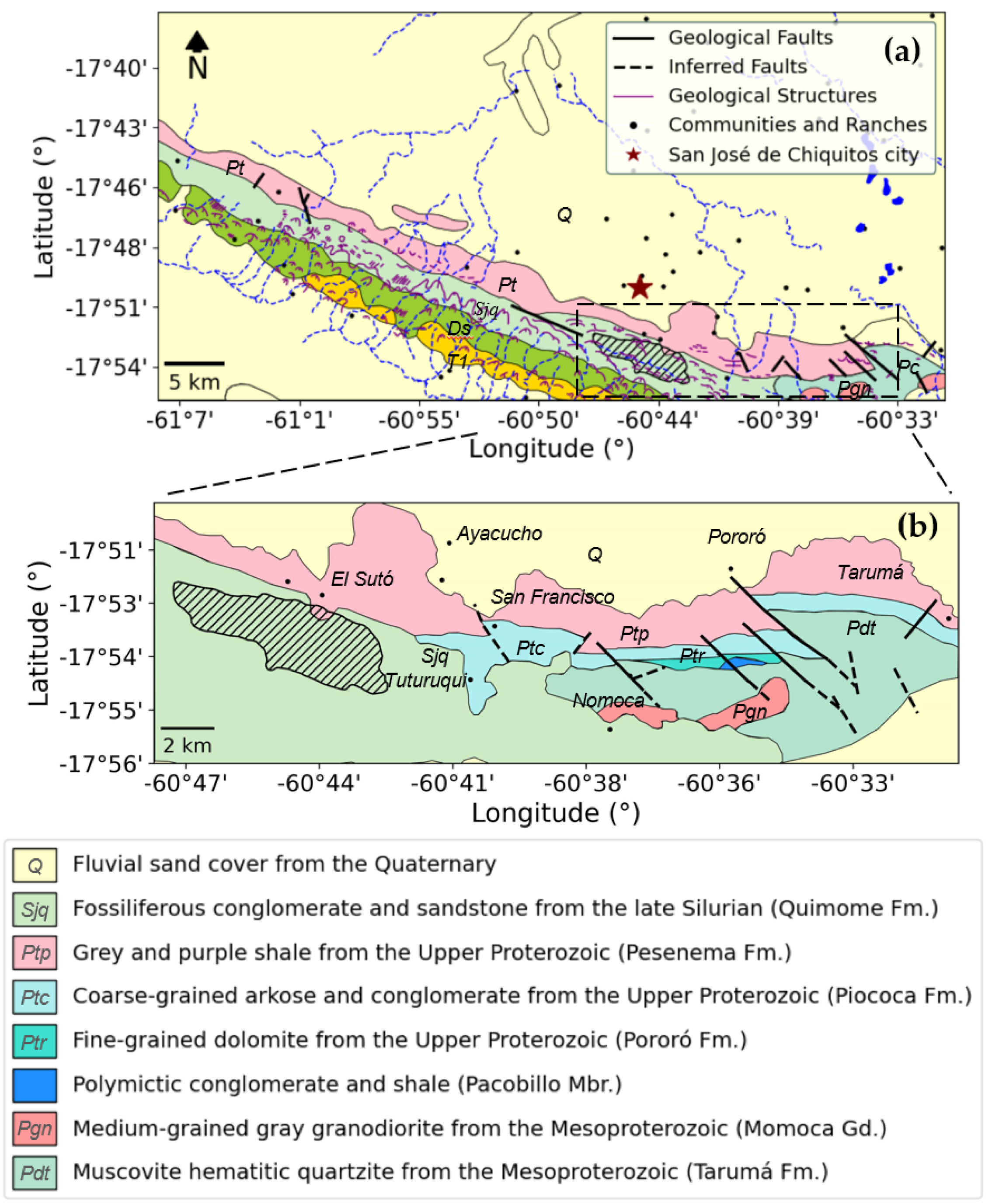
2.2. Hydrological Modeling and Recharge Estimation
| Parameter | Wildfire Severity Scenario (ΔNBR Increases →) | Guidelines/References | |
|---|---|---|---|
| Curve Number (CN II) | CN II = 77 (A), 86 (B), 91 (C), 94 (D) | Ash-patch increments proposed by Batellis and Nalbantis [57], with potential additional rises noted by Soulis [58]. Reflects a post-fire adaptation of the daily SCS-CN method. | |
| Saturated Hydraulic Conductivity (KST) | = constant = unburned value | a b | a Estimated for sandy loams (KST = 0.147 m/h) for 420 < ΔNBR < 886 [24]. b Adjusted for less permeable sandy loams (KST = 0.0325 m/h) [59]. |
2.2.1. Model Setup and Baseline Validation
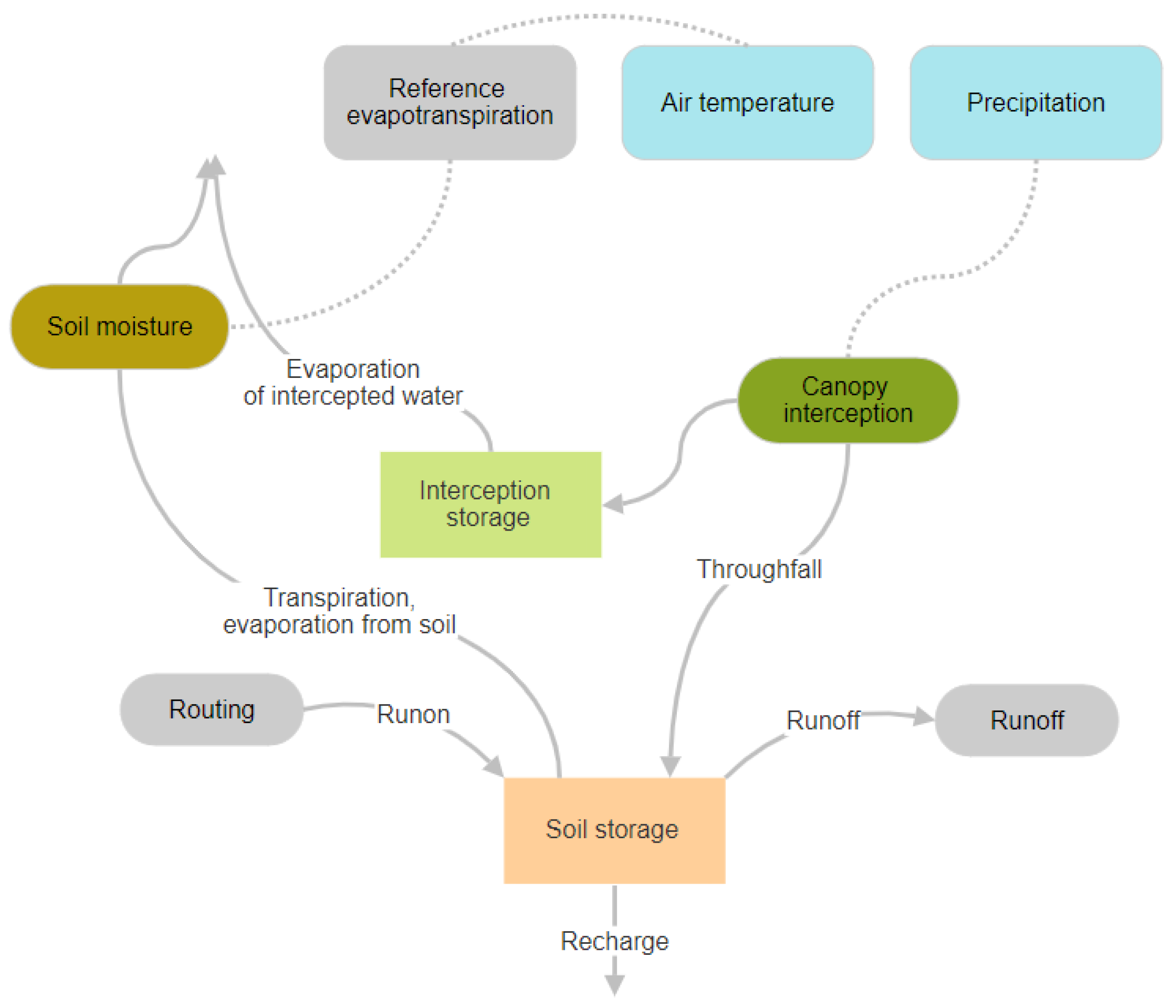
2.2.2. Post-Fire Soil Parameter Adjustments
2.2.3. Large-Scale Validation Proxy and Sensitivity Analysis
2.3. Development of the Fire-Related Forest Recharge Impact Score (FRIS)
3. Results
3.1. Interplay of Soil Parameters in Groundwater Recharge
3.2. Post-Fire Scenario Simulations and Recharge Dynamics
3.3. Development and Guidelines for the Fire-Related Forest Recharge Impact Score (FRIS)
3.4. Large-Scale Validation Proxy of Recharge Variations
4. Discussion
4.1. Post-Fire Hydrological Responses and Implications for Groundwater Recharge
4.2. Fire-Related Forest Recharge Impact Score (FRIS) and Management Implications
5. Conclusions
Author Contributions
Funding
Institutional Review Board Statement
Data Availability Statement
Acknowledgments
Conflicts of Interest
References
- Smith, H.G.; Sheridan, G.J.; Lane, P.N.J.; Nyman, P.; Haydon, S. Wildfire Effects on Water Quality in Forest Catchments: A Review with Implications for Water Supply. J. Hydrol. 2011, 396, 170–192. [Google Scholar] [CrossRef]
- Hallema, D.W.; Robinne, F.-N.; Bladon, K.D. Reframing the Challenge of Global Wildfire Threats to Water Supplies. Earth’s Future 2018, 6, 772–776. [Google Scholar] [CrossRef]
- Robinne, F.-N.; Bladon, K.D.; Miller, C.; Parisien, M.-A.; Mathieu, J.; Flannigan, M.D. A Spatial Evaluation of Global Wildfire-Water Risks to Human and Natural Systems. Sci. Total Environ. 2018, 610–611, 1193–1206. [Google Scholar] [CrossRef]
- Rodrigues, E.L.; Jacobi, C.M.; Figueira, J.E.C. Wildfires and Their Impact on the Water Supply of a Large Neotropical Metropolis: A Simulation Approach. Sci. Total Environ. 2019, 651, 1261–1271. [Google Scholar] [CrossRef]
- Duarte, E.; Rubilar, R.; Matus, F.; Garrido-Ruiz, C.; Merino, C.; Smith-Ramirez, C.; Aburto, F.; Rojas, C.; Stehr, A.; Dörner, J.; et al. Drought and Wildfire Trends in Native Forests of South-Central Chile in the 21st Century. Fire 2024, 7, 230. [Google Scholar] [CrossRef]
- Guzmán-Rojo, M.; Fernandez, J.; d’Abzac, P.; Huysmans, M. Impacts of Wildfires on Groundwater Recharge: A Comprehensive Analysis of Processes, Methodological Challenges, and Research Opportunities. Water 2024, 16, 2562. [Google Scholar] [CrossRef]
- Dudley, N.; Stolton, S. Running Pure The Importance of Forest Protected Areas to Drinking Water; World Bank/WWF Alliance for Forest Conservation and Sustainable Use: Washington, DC, USA, 2013; ISBN 978-2-88085-262-7. [Google Scholar]
- Fienen, M.N.; Arshad, M. The International Scale of the Groundwater Issue. In Integrated Groundwater Management: Concepts, Approaches and Challenges; Jakeman, A.J., Barreteau, O., Hunt, R.J., Rinaudo, J.-D., Ross, A., Eds.; Springer International Publishing: Cham, Switzerland, 2016; pp. 21–48. ISBN 978-3-319-23576-9. [Google Scholar]
- Kinoshita, A.M.; Chin, A.; Simon, G.L.; Briles, C.; Hogue, T.S.; O’Dowd, A.P.; Gerlak, A.K.; Albornoz, A.U. Wildfire, Water, and Society: Toward Integrative Research in the “Anthropocene”. Anthropocene 2016, 16, 16–27. [Google Scholar] [CrossRef]
- Abatzoglou, J.T.; Williams, A.P. Impact of Anthropogenic Climate Change on Wildfire across Western US Forests. Proc. Natl. Acad. Sci. USA 2016, 113, 11770–11775. [Google Scholar] [CrossRef]
- Lohse, K.A.; Billings, S.A.; DiBiase, R.A.; Kumar, P.; Berhe, A.A.; Kaye, J. Soil Signals Tell of Landscape Disturbances. Eos 2020, 101. [Google Scholar] [CrossRef]
- Tyukavina, A.; Potapov, P.; Hansen, M.C.; Pickens, A.H.; Stehman, S.V.; Turubanova, S.; Parker, D.; Zalles, V.; Lima, A.; Kommareddy, I.; et al. Global Trends of Forest Loss Due to Fire from 2001 to 2019. Front. Remote Sens. 2022, 3, 825190. [Google Scholar] [CrossRef]
- Cui, L.; Zhu, C.; Zou, Z.; Yao, C.; Zhang, C.; Li, Y. The Spatiotemporal Characteristics of Wildfires across Australia and Their Connections to Extreme Climate Based on a Combined Hydrological Drought Index. Fire 2023, 6, 42. [Google Scholar] [CrossRef]
- Toledo, N.; Moulatlet, G.; Gaona, G.; Valencia, B.; Hirata, R.; Conicelli, B. Dynamics of Meteorological and Hydrological Drought: The Impact of Groundwater and El Niño Events on Forest Fires in the Amazon. Sci. Total Environ. 2024, 954, 176612. [Google Scholar] [CrossRef] [PubMed]
- Ortega-Becerril, J.A.; Suarez, C.; Vázquez-Tarrío, D.; Garrote, J.; Gomez-Heras, M. Sediment Response after Wildfires in Mountain Streams and Their Effects on Cultural Heritage: The Case of the 2021 Navalacruz Wildfire (Avila, Spain). Fire 2024, 7, 52. [Google Scholar] [CrossRef]
- Pham, H.V.; Le, P.; Berli, M. A Data-Driven Approach to Quantifying the Correlation between Groundwater and Wildfire in the United States. AGU Fall Meeting Abstracts. 2020, p. H087-0025. Available online: https://ui.adsabs.harvard.edu/abs/2020AGUFMH087.0025P/abstract (accessed on 17 February 2025).
- Orlova, J.; Olefeldt, D.; Yasinski, J.H.; Anderson, A.E. Effects of Prescribed Burn on Nutrient and Dissolved Organic Matter Characteristics in Peatland Shallow Groundwater. Fire 2020, 3, 53. [Google Scholar] [CrossRef]
- Rhoades, C.C.; Nunes, J.P.; Silins, U.; Doerr, S.H. The Influence of Wildfire on Water Quality and Watershed Processes: New Insights and Remaining Challenges. Int. J. Wildland Fire 2019, 28, 721–725. [Google Scholar] [CrossRef]
- Robichaud, P.R. Fire Effects on Infiltration Rates after Prescribed Fire in Northern Rocky Mountain Forests, USA. J. Hydrol. 2000, 231–232, 220–229. [Google Scholar] [CrossRef]
- DeBano, L.F. The Role of Fire and Soil Heating on Water Repellency in Wildland Environments: A Review. J. Hydrol. 2000, 231–232, 195–206. [Google Scholar] [CrossRef]
- Farid, A.; Alam, M.K.; Goli, V.S.N.S.; Akin, I.D.; Akinleye, T.; Chen, X.; Cheng, Q.; Cleall, P.; Cuomo, S.; Foresta, V.; et al. A Review of the Occurrence and Causes for Wildfires and Their Impacts on the Geoenvironment. Fire 2024, 7, 295. [Google Scholar] [CrossRef]
- da Silva Junior, J.A.; Pacheco, A.d.P.; Ruiz-Armenteros, A.M.; Henriques, R.F.F. Comparative Analysis between Remote Sensing Burned Area Products in Brazil: A Case Study in an Environmentally Unstable Watershed. Fire 2024, 7, 238. [Google Scholar] [CrossRef]
- Ebel, B.A.; Moody, J.A. Rethinking Infiltration in Wildfire-Affected Soils. Hydrol. Process. 2013, 27, 1510–1514. [Google Scholar] [CrossRef]
- Moody, J.A.; Ebel, B.A.; Nyman, P.; Martin, D.A.; Stoof, C.; McKinley, R.; Moody, J.A.; Ebel, B.A.; Nyman, P.; Martin, D.A.; et al. Relations between Soil Hydraulic Properties and Burn Severity. Int. J. Wildland Fire 2015, 25, 279–293. [Google Scholar] [CrossRef]
- Stathatou, P.-Μ.; Kampragou, E.; Grigoropoulou, H.; Assimacopoulos, D.; Karavitis, C.; Porto, M.F.A.; Gironás, J.; Vanegas, M.; Reyna, S. Vulnerability of Water Systems: A Comprehensive Framework for Its Assessment and Identification of Adaptation Strategies. Desalination Water Treat. 2016, 57, 2243–2255. [Google Scholar] [CrossRef]
- Fannakh, A.; Farsang, A. DRASTIC, GOD, and SI Approaches for Assessing Groundwater Vulnerability to Pollution: A Review. Environ. Sci. Eur. 2022, 34, 77. [Google Scholar] [CrossRef]
- Foster, S. Fundamental concepts in aquifer vulnerability, pollution risk and protection strategy. In Proceedings of the Vulnerability of Soil and Groundwater to Polluants International Conference, Noordwijk aan Zee, The Netherlands, 30 March–3 April 1987; pp. 69–86. [Google Scholar]
- Bai, L.; Wang, Y.; Meng, F. Application of DRASTIC and Extension Theory in the Groundwater Vulnerability Evaluation. Water Environ. J. 2012, 26, 381–391. [Google Scholar] [CrossRef]
- Frans, L.M.; Rupert, M.G.; Hunt, C.D., Jr.; Skinner, K.D. Groundwater Quality in the Columbia Plateau, Snake River Plain, and Oahu Basaltic-Rock and Basin-Fill Aquifers in the Northwestern United States and Hawaii, 1992–2010; U.S. Geological Survey: Reston, VA, USA, 2012. [Google Scholar]
- Mair, A.; El-Kadi, A.I. Logistic Regression Modeling to Assess Groundwater Vulnerability to Contamination in Hawaii, USA. J. Contam. Hydrol. 2013, 153, 1–23. [Google Scholar] [CrossRef]
- Ravbar, N.; Goldscheider, N. Comparative Application of Four Methods of Groundwater Vulnerability Mapping in a Slovene Karst Catchment. Hydrogeol. J. 2009, 17, 725–733. [Google Scholar] [CrossRef]
- Jiang, G.; Guo, F.; Polk, J.S.; Kang, Z.; Wu, J. Delineating Vulnerability of Karst Aquifers Using Hydrochemical Tracers in Southwestern China. Environ. Earth Sci. 2015, 74, 1015–1027. [Google Scholar] [CrossRef]
- Morales García, R.; Ruiz Hernández, J.M.; Orden Gómez, J.A.d.l.; Gómez Gómez, J.d.D.; Moreno Merino, L.; Domínguez Sánchez, J.A.; García Bravo, N.; Durán Valsero, J.J. Incendios Forestales y Aguas Subterráneas: Un Análisis de los Efectos Ambientales y Económicos Sobre los Acuíferos; CSIC—Instituto Geológico y Minero de España (IGME): Madrid, Spain, 2020. [Google Scholar]
- Maillard, O.; Herzog, S.K.; Soria-Auza, R.W.; Vides-Almonacid, R. Impact of Fires on Key Biodiversity Areas (KBAs) and Priority Bird Species for Conservation in Bolivia. Fire 2022, 5, 4. [Google Scholar] [CrossRef]
- Instituto Cruceño de Estadística. Informe Estadístico de Incendios Forestales en Santa Cruz 2024: Incendios Forestales en Santa Cruz Gestión 2023; Gobierno Autónomo Departamental de Santa Cruz: Santa Cruz, Bolivia, 2024; 36p. Available online: https://ice.santacruz.gob.bo/ (accessed on 22 August 2024).
- Carmenta, R.; Parry, L.; Blackburn, A.; Vermeylen, S.; Barlow, J. Understanding Human-Fire Interactions in Tropical Forest Regions: A Case for Interdisciplinary Research across the Natural and Social Sciences. Ecol. Soc. 2011, 16, 53. [Google Scholar] [CrossRef]
- Devisscher, T.; Malhi, Y.; Boyd, E. Deliberation for Wildfire Risk Management: Addressing Conflicting Views in the Chiquitania, Bolivia. Geogr. J. 2019, 185, 38–54. [Google Scholar] [CrossRef]
- Bustillo Sánchez, M.; Tonini, M.; Mapelli, A.; Fiorucci, P. Spatial Assessment of Wildfires Susceptibility in Santa Cruz (Bolivia) Using Random Forest. Geosciences 2021, 11, 224. [Google Scholar] [CrossRef]
- Devisscher, T.; Boyd, E.; Malhi, Y. Anticipating Future Risk in Social-Ecological Systems Using Fuzzy Cognitive Mapping: The Case of Wildfire in the Chiquitania, Bolivia. Ecol. Soc. 2016, 21, 4. [Google Scholar] [CrossRef]
- Gobierno Autónomo Departamental de Santa Cruz. Política Departamental de Manejo Integral de Fuego a 25 Años; Gaceta Oficial del Departamento de Santa Cruz: Santa Cruz, Bolivia, 2024. [Google Scholar]
- Meng, Y.; Deng, Y.; Shi, P. Mapping Forest Wildfire Risk of the World. In World Atlas of Natural Disaster Risk; Shi, P., Kasperson, R., Eds.; Springer: Berlin, Heidelberg, 2015; pp. 261–275. ISBN 978-3-662-45430-5. [Google Scholar]
- Crespo, M. Bolivia’s Chiquitanía Running Out of Water. 10 October 2022. Available online: https://greenmarked.it/bolivias-chiquitania-running-out-of-water/ (accessed on 9 February 2024).
- Fernandez, J.; Maillard, O.; Uyuni, G.; Guzmán-Rojo, M.; Escobar, M. Multi-Criteria Prioritization of Watersheds for Post-Fire Restoration Using GIS Tools and Google Earth Engine: A Case Study from the Department of Santa Cruz, Bolivia. Water 2023, 15, 3545. [Google Scholar] [CrossRef]
- Killeen, T.J.; Jardim, A.; Mamani, F.; Rojas, N. Diversity, Composition and Structure of a Tropical Semideciduous Forest in the Chiquitanía Region of Santa Cruz, Bolivia. J. Trop. Ecol. 1998, 14, 803–827. [Google Scholar] [CrossRef]
- Instituto Nacional de Estadística. Available online: https://www.ine.gob.bo/ (accessed on 27 August 2023).
- Curro Vela, G. Reseña Histórica de La Investigación Geológica y Del Desarrollo Minero En El Precámbrico Boliviano. In Proceedings of the Memoria II Simposio Internacional Geologia y Metalogenia Del Precámbrico Boliviano, San Ramón, Bolivia, 3–4 September 2014; pp. 40–44. [Google Scholar]
- Appleton, J.D.; Llanos, A. Prospección Geoquímica por Metales Base en la Ínsula de San José de Chiquitos (Technical Report No. 16, Ae-PRE-0016e); Ministerio de Minería y Metalurgia, República de Bolivia; Overseas Development Administration (ODA), Foreign and Commonwealth Office, United Kingdom of Great Britain and Northern Ireland: Santa Cruz de la Sierra, Bolivia, 1982. [Google Scholar]
- Servicio Nacional de Geología y Minería; Yacimientos Petrolíferos Fiscales Bolivianos (Eds.) Mapa Geológico de Bolivia, Escala 1:1.000.000; SERGEOMIN|YPFB: La Paz, Bolivia, 2001. [Google Scholar]
- Drew Roca, N.A. Hidrogeoquímica Del Acuífero Del Centro Urbano de San José de Chiquitos, Santa Cruz (Bolivia). Bachelor’s Thesis, Universidad Católica Boliviana San Pablo, Cochabamba, Bolivia, 2021. [Google Scholar]
- Gobierno Autónomo Departamental de Santa Cruz. Plan de Manejo Del Area Protegida Santa Cruz La Vieja; Gobierno Autónomo Departamental de Santa Cruz: Santa Cruz, Bolivia, 2011. [Google Scholar]
- Gobierno Autónomo Departamental de Santa Cruz. Plan de Desarrollo Territorial Para El Buen Vivir de San José de Chiquitos; Gobierno Autónomo Departamental de Santa Cruz: Santa Cruz, Bolivia, 2016. [Google Scholar]
- Soil Maps and Databases|FAO SOILS PORTAL|Food and Agriculture Organization of the United Nations. Available online: https://www.fao.org/soils-portal/data-hub/soil-maps-and-databases/en/ (accessed on 19 June 2024).
- Navarro, G.; Ferreira, W. Mapa de Vegetación de Bolivia a Escala 1: 250,000; Edición CD-ROM; RUMBOL SRL: Santa Cruz de la Sierra, Bolivia, 2007. [Google Scholar]
- Quisnancela Cabay, E.L. Assessing Evapotranspiration with Remote Sensing Data of the Natural Vegetated Area around “El Suto” Water Spring—Bolivia. Master’s Thesis, Vrije Universiteit Brussel; Katholieke Universiteit Leuven, Brussels, Belgium, 2021. [Google Scholar]
- Servicio Nacional de Meteorología e Hidrología (SENAMHI) Official Website. Available online: https://senamhi.gob.bo/index.php/inicio (accessed on 27 August 2023).
- Guzmán-Rojo, M. Fire and Water: Assessing Vulnerability and Hydrological Alterations in Groundwater Recharge Post-Wildfire in the Chiquitano Dry Forest, Bolivia. Ph.D. Thesis, Vrije Universiteit Brussel, Brussels, Belgium, 2024. [Google Scholar]
- Batelis, S.-C.; Nalbantis, I. Potential Effects of Forest Fires on Streamflow in the Enipeas River Basin, Thessaly, Greece. Environ. Process. 2014, 1, 73–85. [Google Scholar] [CrossRef]
- Soulis, K.X. Estimation of SCS Curve Number Variation Following Forest Fires. Hydrol. Sci. J. 2018, 63, 1332–1346. [Google Scholar] [CrossRef]
- Atchley, A.L.; Kinoshita, A.M.; Lopez, S.R.; Trader, L.; Middleton, R. Simulating Surface and Subsurface Water Balance Changes Due to Burn Severity. Vadose Zone J. 2018, 17, 180099. [Google Scholar] [CrossRef]
- Westenbroek, S.M.; Engott, J.A.; Kelson, V.A.; Hunt, R.J. SWB Version 2.0—A Soil-Water-Balance Code for Estimating Net Infiltration and Other Water-Budget Components; Techniques and Methods; U.S. Geological Survey: Reston, VA, USA, 2018; Volume 6-A59. [Google Scholar]
- Thornthwaite, C.W.; Mather, J.R. The Water Balance. Publ. Climatol. 1955, 8, 185–311. [Google Scholar]
- Thornthwaite, C.W.; Mather, J.R. Instructions and Tables for Computing Potential Evapotranspiration and the Water Balance. Publ. Climatol. 1957, 10, 1–104. [Google Scholar]
- Dripps, W.R.; Bradbury, K.R. A Simple Daily Soil–Water Balance Model for Estimating the Spatial and Temporal Distribution of Groundwater Recharge in Temperate Humid Areas. Hydrogeol. J. 2007, 15, 433–444. [Google Scholar] [CrossRef]
- Gash, J.H.C. An Analytical Model of Rainfall Interception by Forests. Q. J. R. Meteorol. Soc. 1979, 105, 43–55. [Google Scholar] [CrossRef]
- Cronshey, R. Urban Hydrology for Small Watersheds, 2nd ed.; U.S. Department of Agriculture, Soil Conservation Service, Engineering Division: Washington, DC, USA, 1986. [Google Scholar]
- Hargreaves, S. Reference Crop Evapotranspiration from Temperature. Appl. Eng. Agric. 1985, 1, 96–99. [Google Scholar] [CrossRef]
- Allen, R.G.; Pereira, L.S.; Raes, D.; Smith, M. Crop Evapotranspiration-Guideline for Computing Crop Water Requirements; FAO Irrigation and Drainage Paper 56; Food and Agriculture Organization of the United Nations (FAO): Rome, Italy, 1998; p. 300. [Google Scholar]
- Moody, J.A.; Shakesby, R.A.; Robichaud, P.R.; Cannon, S.H.; Martin, D.A. Current Research Issues Related to Post-Wildfire Runoff and Erosion Processes. Earth-Sci. Rev. 2013, 122, 10–37. [Google Scholar] [CrossRef]
- Loza Cruz, J.J. El Efecto de Los Incendios Forestales En Los Parámetros Hidráulicos Del Suelo Que Influyen La Recarga de Acuíferos En San José de Chiquitos. Bachelor’s Thesis, Universidad Católica Boliviana San Pablo, La Paz, Bolivia, 2024. [Google Scholar]
- McNally, A.; Arsenault, K.; Kumar, S.; Shukla, S.; Peterson, P.; Wang, S.; Funk, C.; Peters-Lidard, C.D.; Verdin, J.P. A Land Data Assimilation System for Sub-Saharan Africa Food and Water Security Applications. Sci. Data 2017, 4, 170012. [Google Scholar] [CrossRef] [PubMed]
- GES DISC. Dataset: FLDAS Noah Land Surface Model L4 Global Monthly 0.1 × 0.1 Degree (MERRA-2 and CHIRPS) (FLDAS_NOAH01_C_GL_M 001). Available online: https://disc.gsfc.nasa.gov/datasets/FLDAS_NOAH01_C_GL_M_001/summary (accessed on 16 February 2025).
- Abatzoglou, J.T.; Dobrowski, S.Z.; Parks, S.A.; Hegewisch, K.C. TerraClimate, a High-Resolution Global Dataset of Monthly Climate and Climatic Water Balance from 1958–2015. Sci. Data 2018, 5, 170191. [Google Scholar] [CrossRef]
- Magnoni, P.H.J.; Silva, C.d.O.F.; Manzione, R.L. Groundwater Recharge and Water Table Levels Modelling Using Remotely Sensed Data and Cloud-Computing. Sustain. Water Resour. Manag. 2020, 6, 113. [Google Scholar] [CrossRef]
- Giglio, L.; Boschetti, L.; Roy, D.P.; Humber, M.L.; Justice, C.O. The Collection 6 MODIS Burned Area Mapping Algorithm and Product. Remote Sens. Environ. 2018, 217, 72–85. [Google Scholar] [CrossRef]
- Chander, G.; Markham, B.L.; Helder, D.L. Summary of Current Radiometric Calibration Coefficients for Landsat MSS, TM, ETM+, and EO-1 ALI Sensors. Remote Sens. Environ. 2009, 113, 893–903. [Google Scholar] [CrossRef]
- Silva de Freitas, L. Remotely-Sensed Estimate of Groundwater Recharge and Its Correlation with Deforestation and Fire in Eastern Bolivia. Master’s Thesis, Katholieke Universiteit Leuven, Ghent University, Brussels, Belgium, 2021. [Google Scholar]
- Coritza Taquichiri, E.F. Groundwater Recharge Estimation in Eastern Bolivia Using Remotely-Sensed Hydrometeorological Variables. Master’s Thesis, Vrije Universiteit Brussel; Katholieke Universiteit Leuven, Brussels, Brussels, 2023. [Google Scholar]
- Lazar, J.; Feng, J.H.; Hochheiser, H. (Eds.) Chapter 4—Statistical Analysis. In Research Methods in Human Computer Interaction, 2nd ed.; Morgan Kaufmann: Boston, MA, USA, 2017; pp. 71–104. ISBN 978-0-12-805390-4. [Google Scholar]
- Mills, A.J.; Fey, M.V. Frequent Fires Intensify Soil Crusting: Physicochemical Feedback in the Pedoderm of Long-Term Burn Experiments in South Africa. Geoderma 2004, 121, 45–64. [Google Scholar] [CrossRef]
- Keesstra, S.D.; Maroulis, J.; Argaman, E.; Voogt, A.; Wittenberg, L. Effects of Controlled Fire on Hydrology and Erosion under Simulated Rainfall. Cuad. De Investig. Geográfica 2014, 40, 269–294. [Google Scholar] [CrossRef]
- Stoof, C.R.; Ferreira, A.J.D.; Mol, W.; Van den Berg, J.; De Kort, A.; Drooger, S.; Slingerland, E.C.; Mansholt, A.U.; Ferreira, C.S.S.; Ritsema, C.J. Soil Surface Changes Increase Runoff and Erosion Risk after a Low–Moderate Severity Fire. Geoderma 2015, 239–240, 58–67. [Google Scholar] [CrossRef]
- Benavides-Solorio, J.; MacDonald, L.H. Post-Fire Runoff and Erosion from Simulated Rainfall on Small Plots, Colorado Front Range. Hydrol. Process. 2001, 15, 2931–2952. [Google Scholar] [CrossRef]
- Fallon, K.; Wheelock, S.J.; Sadegh, M.; Pierce, J.L.; McNamara, J.P.; Cattau, M.; Baker, V.R. Post-Fire Hydrologic Analysis: A Tale of Two Severities. Hydrol. Sci. J. 2024, 69, 139–148. [Google Scholar] [CrossRef]
- Ilstedt, U.; Bargués Tobella, A.; Bazié, H.R.; Bayala, J.; Verbeeten, E.; Nyberg, G.; Sanou, J.; Benegas, L.; Murdiyarso, D.; Laudon, H.; et al. Intermediate Tree Cover Can Maximize Groundwater Recharge in the Seasonally Dry Tropics. Sci. Rep. 2016, 6, 21930. [Google Scholar] [CrossRef]
- Ellison, D.; Morris, C.E.; Locatelli, B.; Sheil, D.; Cohen, J.; Murdiyarso, D.; Gutierrez, V.; van Noordwijk, M.; Creed, I.F.; Pokorny, J.; et al. Trees, Forests and Water: Cool Insights for a Hot World. Glob. Environ. Change 2017, 43, 51–61. [Google Scholar] [CrossRef]
- Oliveira, P.T.S.; Leite, M.B.; Mattos, T.; Nearing, M.A.; Scott, R.L.; de Oliveira Xavier, R.; da Silva Matos, D.M.; Wendland, E. Groundwater Recharge Decrease with Increased Vegetation Density in the Brazilian Cerrado. Ecohydrology 2017, 10, e1759. [Google Scholar] [CrossRef]
- Mohan, C.; Western, A.W.; Wei, Y.; Saft, M. Predicting Groundwater Recharge for Varying Land Cover and Climate Conditions—A Global Meta-Study. Hydrol. Earth Syst. Sci. 2018, 22, 2689–2703. [Google Scholar] [CrossRef]
- Zhang, X.; Lindström, G. Development of an Automatic Calibration Scheme for the HBV Hydrological Model. Hydrol. Process. 1997, 11, 1671–1682. [Google Scholar]
- Kundzewicz, Z.W. Climate Change Impacts on the Hydrological Cycle. Ecohydrol. Hydrobiol. 2008, 8, 195–203. [Google Scholar] [CrossRef]
- Barlow, J.; Peres, C.A. Fire-Mediated Dieback and Compositional Cascade in an Amazonian Forest. Philos. Trans. R. Soc. B Biol. Sci. 2008, 363, 1787–1794. [Google Scholar] [CrossRef]
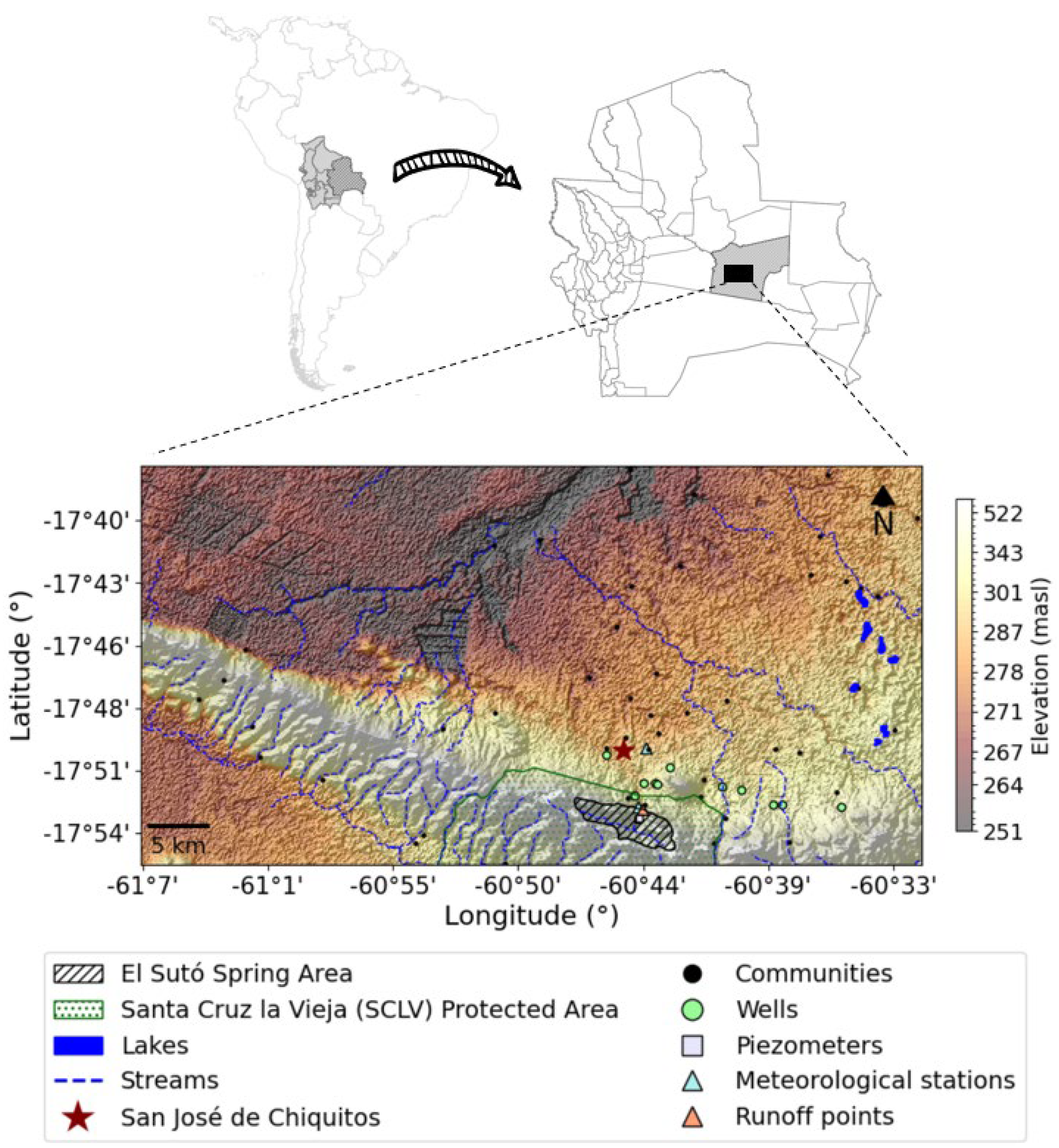
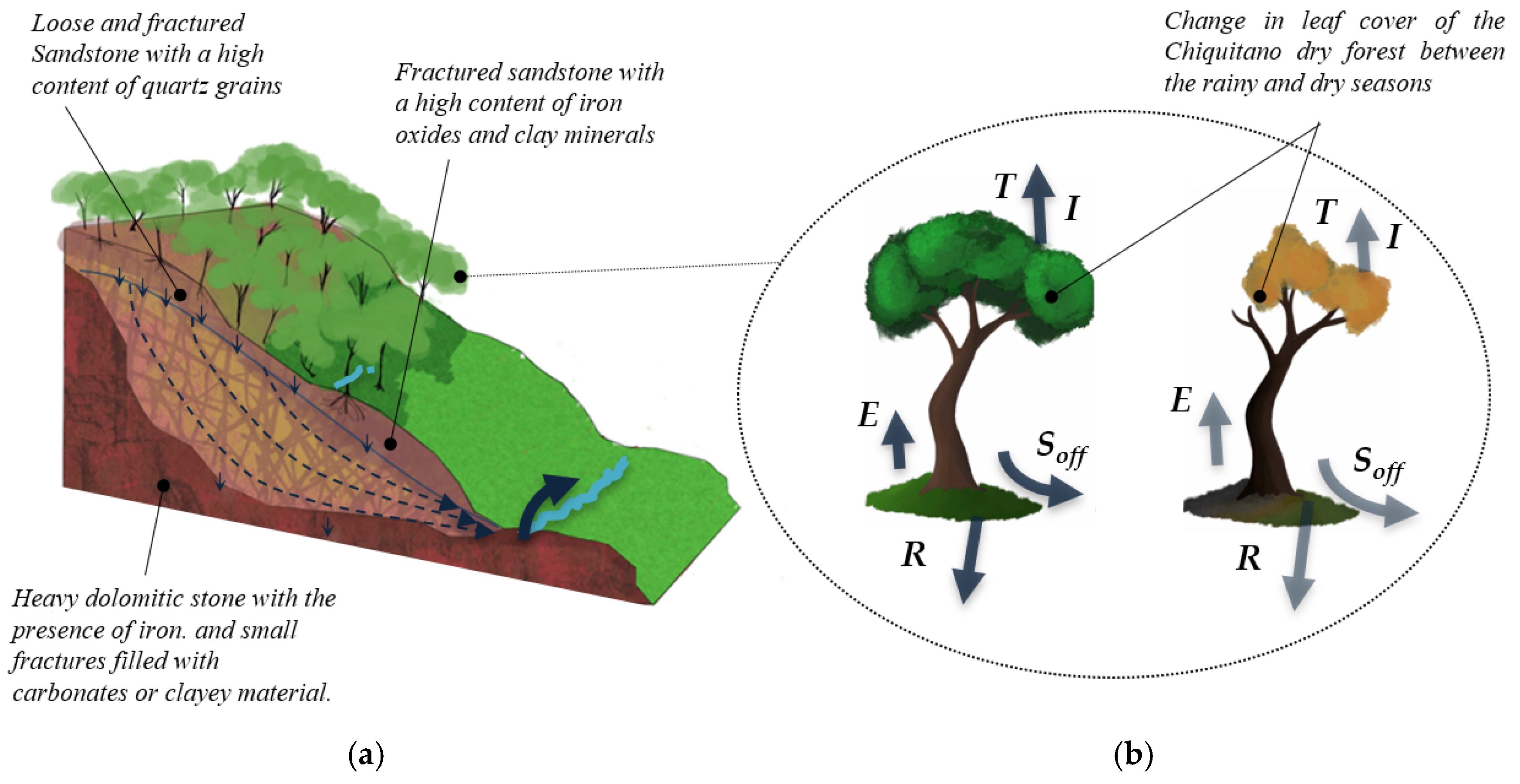


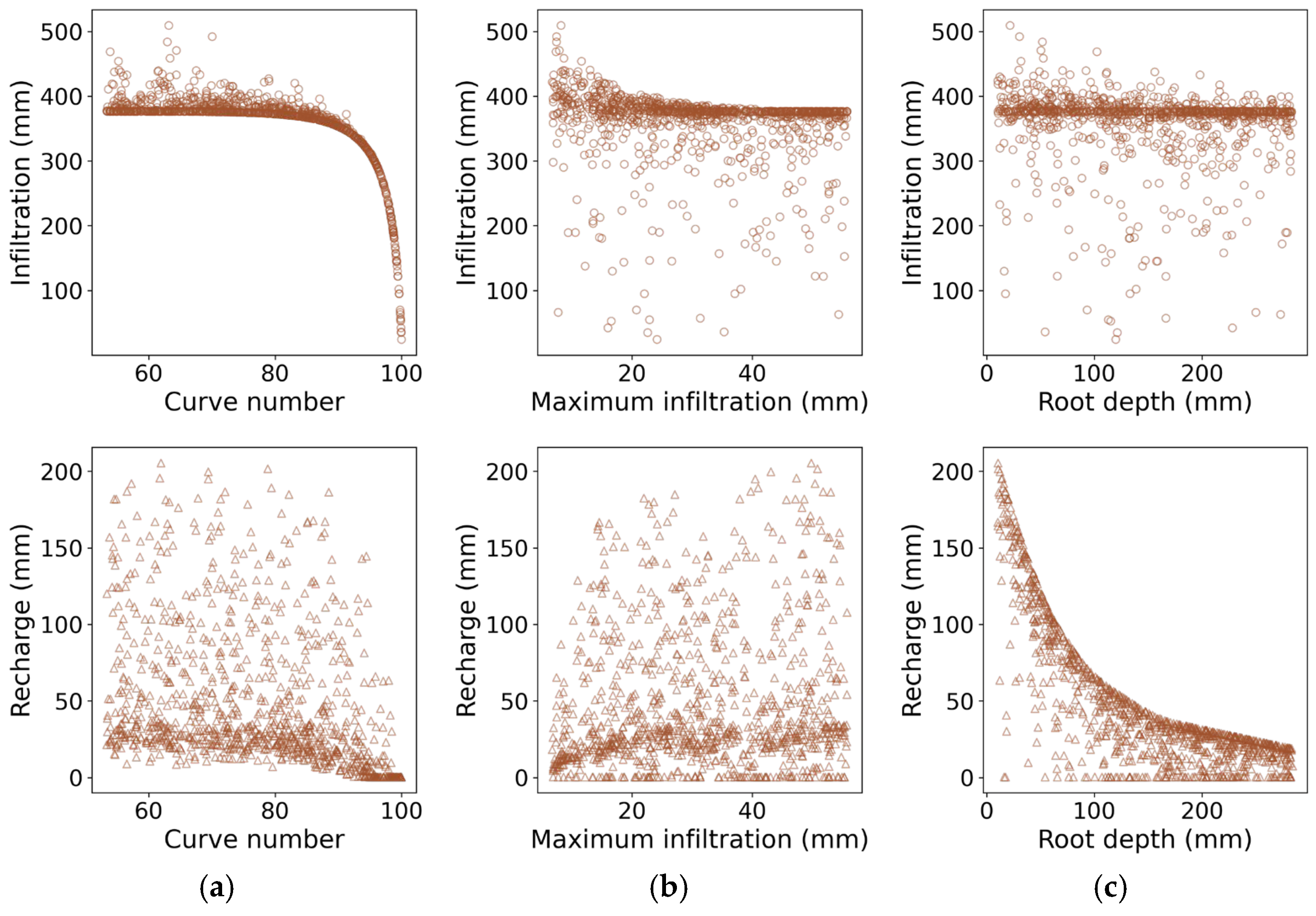

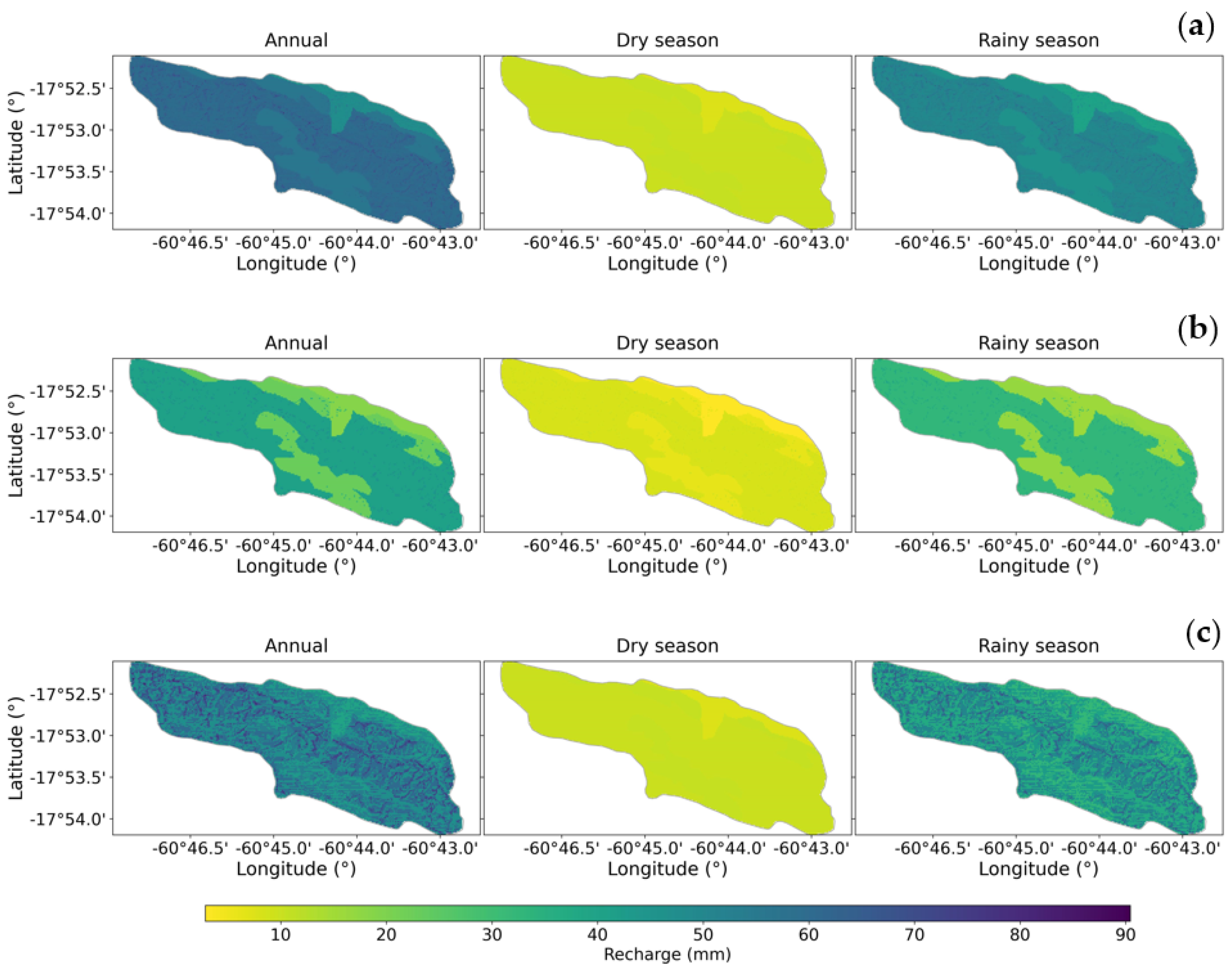
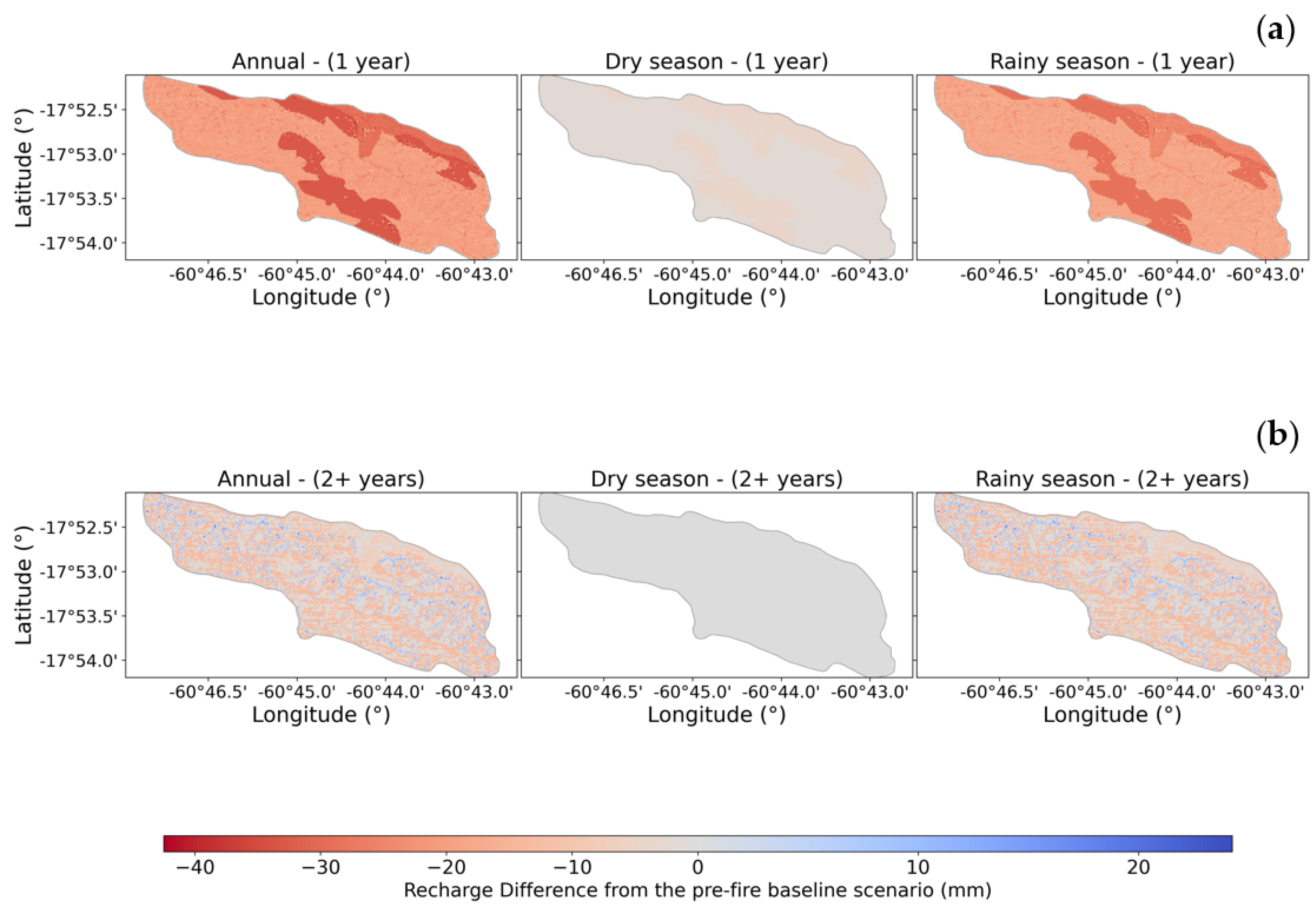
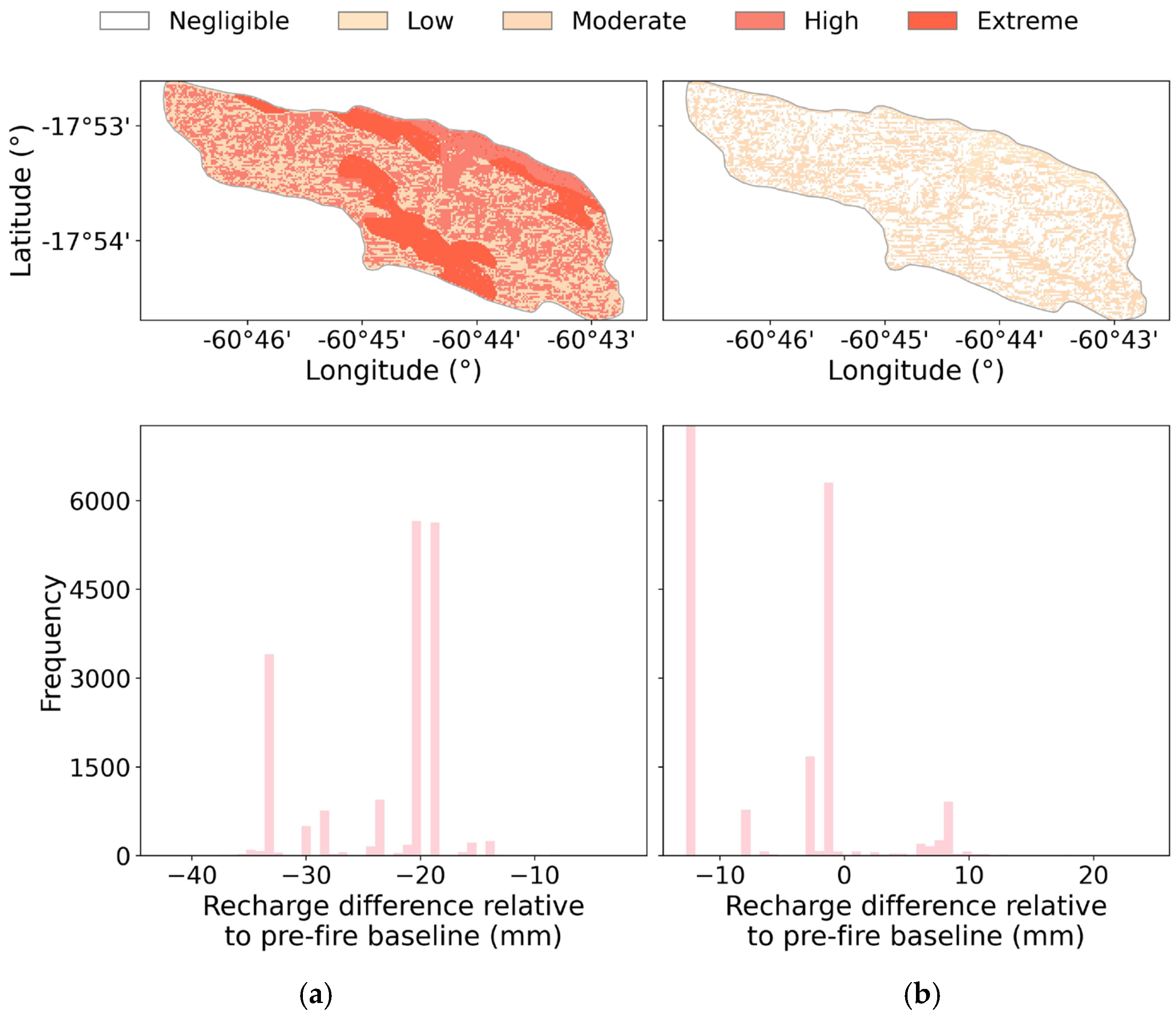
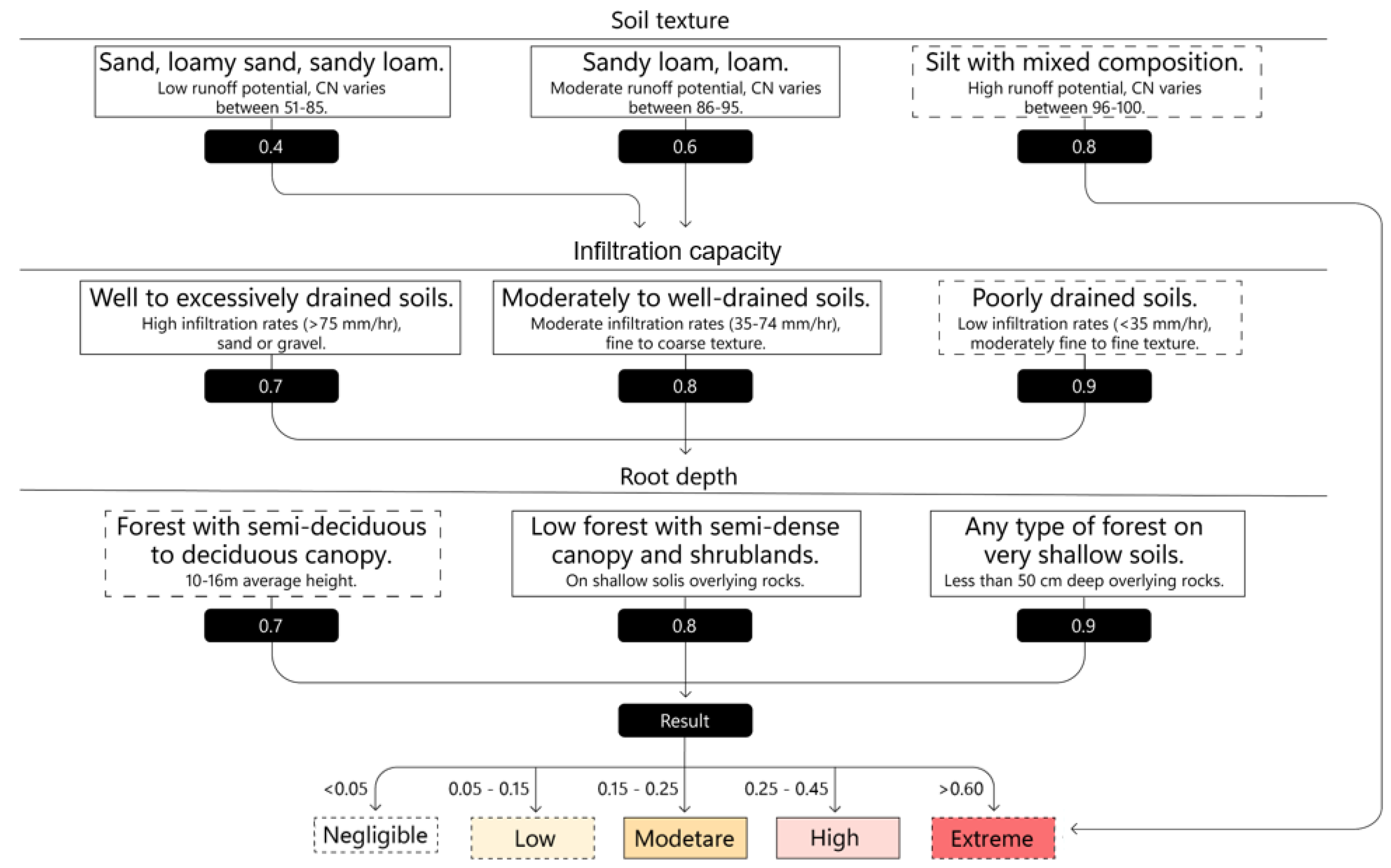
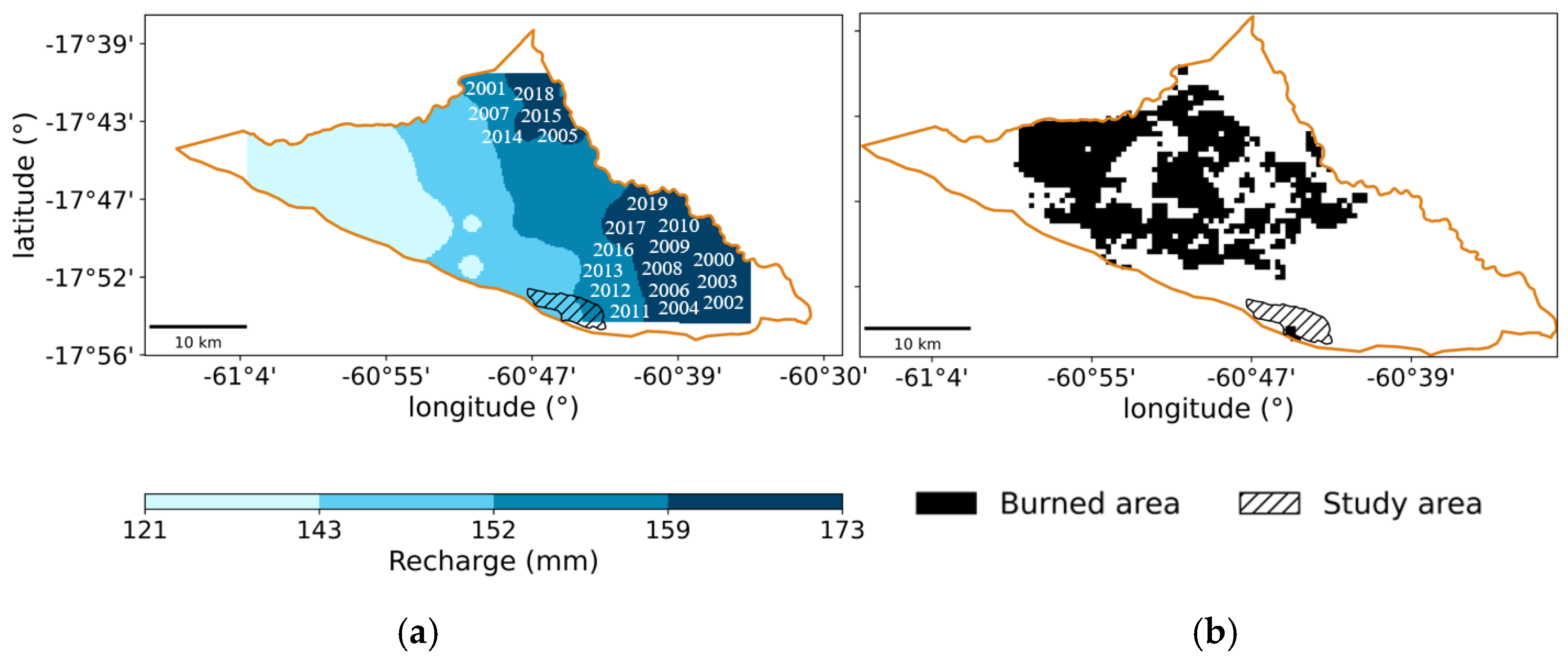
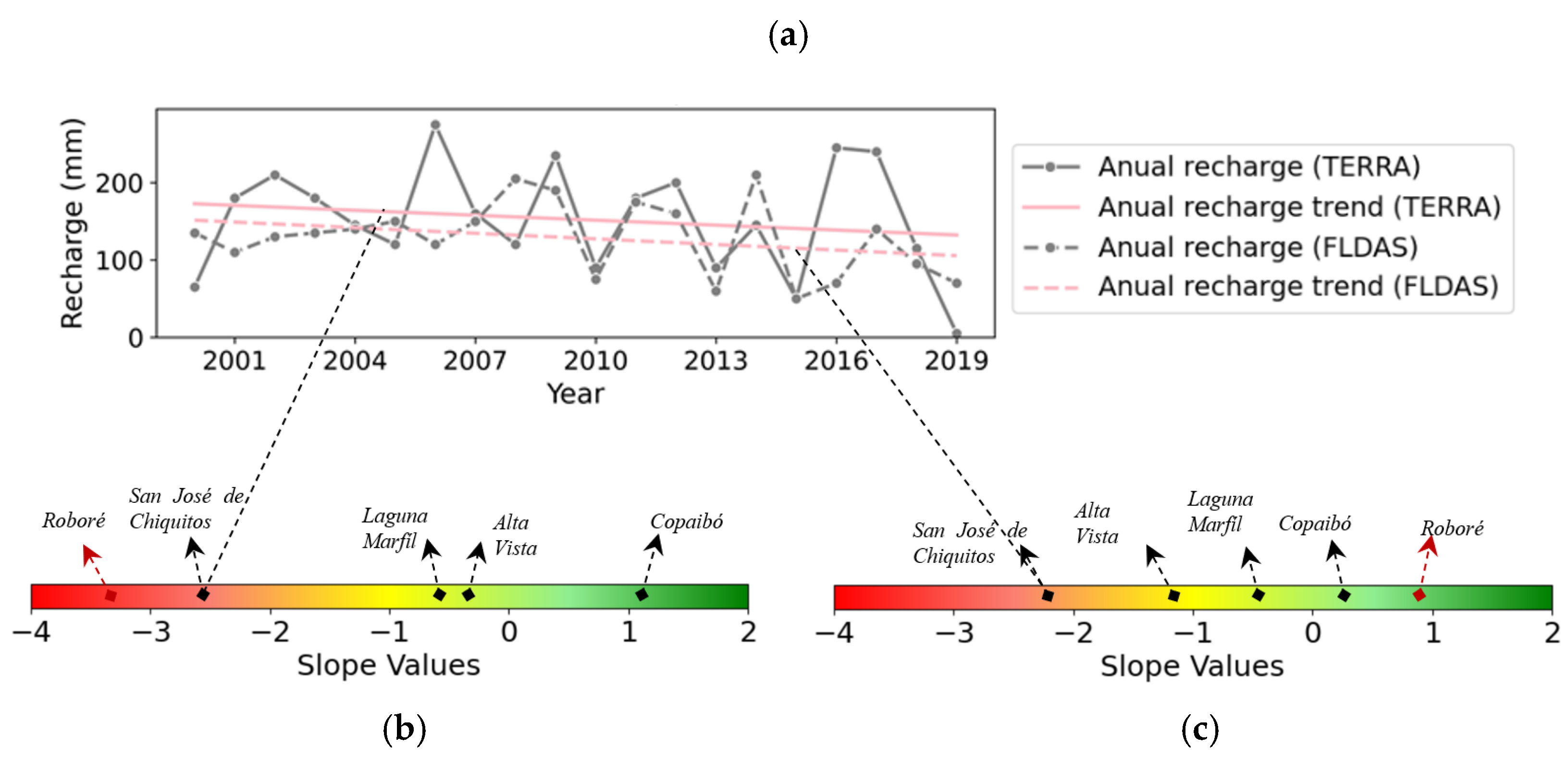
| Zone | Description (Soils and Vegetation) | Pre-Fire CN | Post-Fire CN |
|---|---|---|---|
| Type B (lower zone) | Soils with extensive rocky outcrops, variable slopes, significant erosion, and excessive drainage. These soils exhibit light-to-medium textures, acidic pH, and low fertility (classified as Leptosol Lithic, Leptosol Aridic, and Cambisol Leptic). Vegetation is diverse, including components of the Cerrado unit and transitional chaparral formations. | 55 | 86 |
| Type C (upper zone) | Shallow soils developed over inclined sandstone with occasional rock outcrops. These soils present textures ranging from moderately coarse to moderately fine, slightly excessive drainage, acidic pH, and low fertility (classified as Ferralsol Haplic, Cambisol Distric, Leptosol Lithic, and Acrisol Alumic). Semi-deciduous forests predominantly cover this area. | 70 | 91 |
| Parameter | Observed Range/Threshold | Infiltration Response | Recharge Response | Additional Notes |
|---|---|---|---|---|
| Curve Number (CN) | CN ≤ 85: behavior is relatively stable CN > 85: sharp decline, approaching zero at CN = 100 | Remains near ~380 mm for CN ≤ 85; declines sharply as CN increases | Decreases linearly; ~25 mm at CN = 80, dropping to near 0 beyond CN = 95 | Notable discontinuity in recharge when CN exceeds 96 |
| Maximum infiltration (Imax) | Imax between 20 and 60 mm: stable behavior Imax < 20 mm: high variability in responses | Remains consistently ~380 mm for Imax between 20 and 60 mm; highly variable below 20 mm | Stable around ~25 mm for Imax between 20 and 60 mm; decreases linearly below 20 mm | Recharge discontinuity is observed when Imax falls below 25 mm |
| Root zone depth (Rzn) | Rzn from 20 to 300 mm Marked decline in recharge up to ~100 mm, with less pronounced trend thereafter | Remains stable across the range of Rzn | Decreases markedly—from ~200 mm at Rzn = 20 mm to ~20 mm at Rzn = 300 mm—with steep decline until ~100 mm, then more gradual decline | Root-zone depth exerts strong influence on recharge trends |
| Vulnerability Category | Annual Recharge Loss (mm) | Approximate Depletion Fraction | Characteristics |
|---|---|---|---|
| Negligible | 0 to −5 | 0.04 | Minor vulnerabilities are typically seen in areas with minimal recharge loss. |
| Low | −5 to −10 | 0.13 | Indicates a low vulnerability level with slightly more noticeable recharge loss. |
| Moderate | −10 to −20 | 0.25 | Indicates an intermediate level of vulnerability, where the impact of recharge loss becomes more noticeable. |
| High | −20 to −30 | 0.42 | This shows a high level of vulnerability and substantial recharge loss that could significantly impact the area’s hydrology. |
| Extreme | −30 to −40 | 0.59 | Represents severe vulnerability, indicating significant recharge loss and potential hydrological disruption. |
Disclaimer/Publisher’s Note: The statements, opinions and data contained in all publications are solely those of the individual author(s) and contributor(s) and not of MDPI and/or the editor(s). MDPI and/or the editor(s) disclaim responsibility for any injury to people or property resulting from any ideas, methods, instructions or products referred to in the content. |
© 2025 by the authors. Licensee MDPI, Basel, Switzerland. This article is an open access article distributed under the terms and conditions of the Creative Commons Attribution (CC BY) license (https://creativecommons.org/licenses/by/4.0/).
Share and Cite
Guzmán-Rojo, M.; Silva de Freitas, L.; Coritza Taquichiri, E.; Huysmans, M. Groundwater Vulnerability in the Aftermath of Wildfires at the El Sutó Spring Area: Model-Based Insights and the Proposal of a Post-Fire Vulnerability Index for Dry Tropical Forests. Fire 2025, 8, 86. https://doi.org/10.3390/fire8030086
Guzmán-Rojo M, Silva de Freitas L, Coritza Taquichiri E, Huysmans M. Groundwater Vulnerability in the Aftermath of Wildfires at the El Sutó Spring Area: Model-Based Insights and the Proposal of a Post-Fire Vulnerability Index for Dry Tropical Forests. Fire. 2025; 8(3):86. https://doi.org/10.3390/fire8030086
Chicago/Turabian StyleGuzmán-Rojo, Mónica, Luiza Silva de Freitas, Enrrique Coritza Taquichiri, and Marijke Huysmans. 2025. "Groundwater Vulnerability in the Aftermath of Wildfires at the El Sutó Spring Area: Model-Based Insights and the Proposal of a Post-Fire Vulnerability Index for Dry Tropical Forests" Fire 8, no. 3: 86. https://doi.org/10.3390/fire8030086
APA StyleGuzmán-Rojo, M., Silva de Freitas, L., Coritza Taquichiri, E., & Huysmans, M. (2025). Groundwater Vulnerability in the Aftermath of Wildfires at the El Sutó Spring Area: Model-Based Insights and the Proposal of a Post-Fire Vulnerability Index for Dry Tropical Forests. Fire, 8(3), 86. https://doi.org/10.3390/fire8030086









